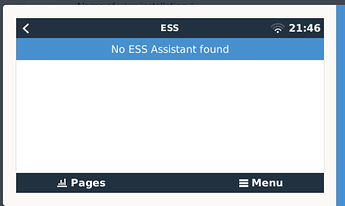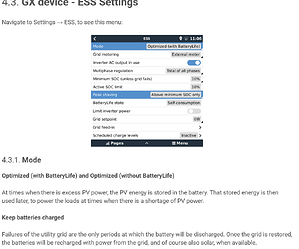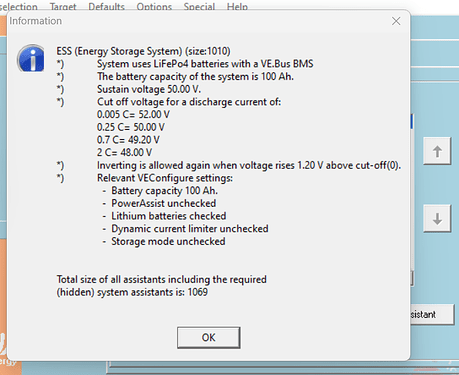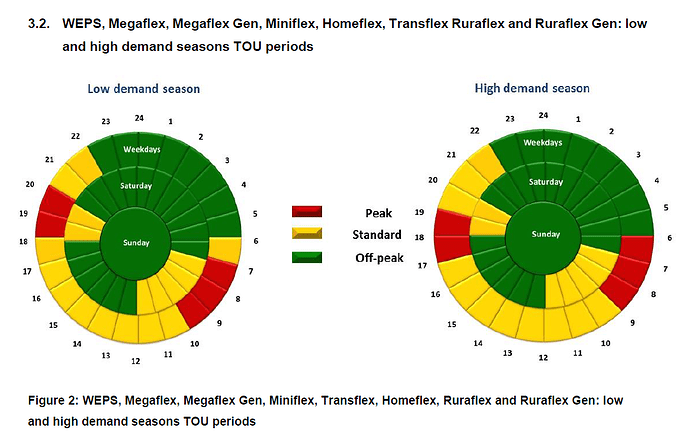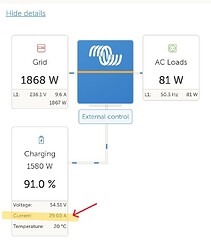I’m going to ask around the suburb because we’ll probably need to do a class action / mass action. We’ve already had a couple of low voltage incidents/brownouts but I don’t think many people have the gadgets to notice over-voltage. I initially couldn’t figure why the inverter had disconnected last night and stepped outside to see whether everyone else had lights (they did). I’ll monitor for a bit because I think it’s got to do with the fluctuating supply.
Actually, you are not the first to have this issue. A few before have also (understandably) had little hope beforehand, only to have the issue sorted within days.
By all means, escalate the issue if you get no timeous response. Still, I think your direct supplier has adjusted the voltage up the way to cater for a significant voltage drop, as everyone’s load comes on simultaneously after LS.
The supplier may have over-compensated in your area and maybe only too happy to hear about the customer experience.
Just leave the “Smurf” out of the discussion, and base your request on concern for your other household appliances.
I might have cured myself of that already ![]() I updated the Remote Console firmware this afternoon (after having first checked whether it was in any way like older Windows i.e. avoid anything short of a consolidated service pack), was pleased that the router and computer would stay up on their own if the inverter had to switch off and restart, everything seemed to have gone well, and suddenly there was an Alarm: Device cannot transmit data! I was within an inch of speed-dialling and howling: “I’ve broken it!”.
I updated the Remote Console firmware this afternoon (after having first checked whether it was in any way like older Windows i.e. avoid anything short of a consolidated service pack), was pleased that the router and computer would stay up on their own if the inverter had to switch off and restart, everything seemed to have gone well, and suddenly there was an Alarm: Device cannot transmit data! I was within an inch of speed-dialling and howling: “I’ve broken it!”.
That’s cured me from anything except madly playing around in Demo and Fake, followed by a long email to Babysitter explaining what tweaks I might like, and why, and would he be so kind etc.
I was thinking about the business model. Victron is obviously for afficionados and tech heads (and scaredy-cats like me who prioritised being able to find a distributor and installer off Victron’s own website + track record and support). But it must be hard on an installer to have to field umpteen questions from an ignorant client, who might have unrealistic expectations, and post-install must be a particular nightmare. I’m not surprised that they lock the settings and release a few only under supervision.
I’ve offered up standing invitations to lunch but honestly, I would be happy with a separate post-install contract to babysit. Leaving aside warranties and ignorant fingers causing explosions, it hardly seems fair for them to have to make sense of what a client is asking and then make it happen (or explain why it can’t happen).
PS They say they couldn’t find an inbuilt way to “delay reconnecting after grid is healthy” so the Clearline TripConnect is on the cards ex abundanti cautela ![]() and “discreet AC input” is the additional thing to not strain the grid
and “discreet AC input” is the additional thing to not strain the grid ![]()
Victron has many options, see what you like, with assistance, set it then yourself after suggestions from here if needed.
Try it. It is dead simple. You cannot “break” it … having read the manuals a bit.
Me, I just look at the pictures …
And if you do “break” it … if the Cerbo is online, it can be “reverted” … as it is mostly settings.
Try it … why not?
Me, I just look at the pictures …
This is so essential to me! It’s only when I start flowcharting something that I get the hang of how it fits together!
Hmmmm I think the features I want are in ESS.
https://community.victronenergy.com/questions/72209/feature-request-multiplus-time-of-day-programming.html
This sounds if it can be tweaked to “don’t charge during the two Eskom peaks; charge at any other time”: 4. Configuration ( 4.4. GX device - Scheduled charge levels): "The Scheduled charge levels setting … allows you to set up to five scheduled periods, during which the system will take power from the grid to charge the battery. This is typically used to charge the battery during off-peak tariff time windows (TOU). For each schedule, configure a start time, the duration, a SoC limit (target) and the self-consumption limit behaviour. … enables more flexible planning of the charge slots in the event of scheduled outages (load shedding schedules). … "
But my ESS is mysteriously blank!
instead of having the useful things displayed in Ch 4.4.1:
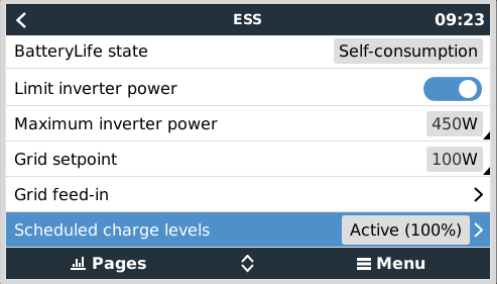
or 4.3:
Then I see para para 4.4.2: " Scheduled charge levels … is only available when the ESS mode is set to Optimised. Scheduled charge levels naturally makes no sense when the mode is set to Keep Batteries Charged."
Is ESS is available to a UPS system??? That’s my point of departure before I start chasing ESS.
(It sounds like there might be something relevant here but I can’t make out exactly what the chat is about.
Shaneyake answered:“The UPS function is always enabled when ESS is selected for SA. It is because the grid code sets the transfer time.”
https://community.victronenergy.com/questions/142576/enable-ups-function-with-ess.html
Enable the ESS function on the inverter. It is under Assistants in VE.Configure.
So what you don’t have panels. Have some fun with that, learn, and see what features there you can use.
I did that with my 500va Multiplus.
Park that for now … unless the big manne says otherwise here.
We’re on Eskom Direct (and the service is actually terrific. Kyalami, next to Megawatt Park, so they’re probably nervous we’ll vomit on their lawn if they’re not reasonably efficient. And our ward councilor is absolutely sterling about finding out what’s going on).
The burning question: how do I report suspected over-voltage without mentioning how I measured/noticed it? What is the non-Smurf gadget that I can plausibly refer to?
The idiot bot Alfred wouldn’t notice but they typically send out technicians when there’s a hassle (and typically within 24 or 48 hours if it’s a household issue), which is also why I’d prefer to ring through (or ask the ward councilor to ring through) to say: “It’s the whole suburb plus the two adjoining, no need to send anyone home”. Imagine if the Smurf gives its Smurf-grunt from the Smurf room while Eskom is frowning over my DB board ![]() )
)
Do you have normal fans in the house running?
As the volts increase from the supply, they will run faster and faster … use that.
… or the Tripconnect.
But I see no reason why you cannot give someone at the council, your ward politician, the graph of the Smurf, to show the volts that high.
Except that I’m running VEConfig in “Fake target from (actual) file” mode because my babysitter’s nervous ![]() Only he will have actual access, but I can petition.
Only he will have actual access, but I can petition.
I actually went through the “Enable ESS Assistant” just before I posted, thinking “fake target, right; diligently read the welcome/warning, accept their standard settings”. Result:
Then I wanted to close the app, at which point this screen popped up. I was “are we still playing Fake or is this now Real? Hell No!”

I’ll petition the babysitter tomorrow. I have to speak to him about going back to the drawing board: his switching the AC input from 50A to 25A notwithstanding, the battery still recharged at 2000W (9.6A) when the grid was restored ![]()
Yes, sometimes the inverter will reboot to save the correct information on the chips inside it,it warns you.
So what, just plan for it … because you will have switched the house back to the main DB, and their is no LS pending.
Easy see.
![]() Obi Wan! (The TripConnect hasn’t yet been installed. I must chase the installers because I don’t want a different electrician working on the main DB at this point in time.)
Obi Wan! (The TripConnect hasn’t yet been installed. I must chase the installers because I don’t want a different electrician working on the main DB at this point in time.)
I’ll drop the councilor the evidence (and ask neighbours with gadgets to also screenshot). I see the voltage has been misbehaving again ![]() There was a three-suburb-wide two-hour unplanned outage post load-shedding so something has definitely gone pear-shaped.
There was a three-suburb-wide two-hour unplanned outage post load-shedding so something has definitely gone pear-shaped.
Seeing how you write @Dorothy, thought I share something back …,
Who is this TTT?
Just so you know … the list has grown since then.
I’ll share “good” bits of advice here for you on your system … together we can rule this world! ![]()
Ok seriously now, some of the more cautious (read experienced) okes here will step in if we go too far or fast for you, on this journey of yours … I hope. ![]()
I do like how you read and investigate … Victron is really cool kit to do big things with, NodeRED and/or HomeAssistant is in your future too I see. Just keep your babysitter close by … send him here, not many people have the guts to do what you are doing.
Keep going!
PS. I press the button, then I read the manual.
the list has grown since then.
![]()
![]()
![]()
My worst was deleting the video drivers while “dusting” my desktop. The computer said “unknown device”, I went “delete”. It was said that my screams could be heard down the road ![]() I managed the reinstall using whatever crude home networking was available 20 years ago but lesson learned: I first read for structure before I press any button
I managed the reinstall using whatever crude home networking was available 20 years ago but lesson learned: I first read for structure before I press any button ![]() But after that (and after creating a restore point), doing (or watching and asking questions) is my best way of learning. But preferably without explosions
But after that (and after creating a restore point), doing (or watching and asking questions) is my best way of learning. But preferably without explosions ![]()
I so appreciate all the insights on the forum ![]()
![]() I’m definitely going to nudge my babysitter to join: it’s one of the quite large firms in Pretoria but I reckon the poor guy could do with the support. He always sounds a little harassed and stressed, probably by everyone phoning in to demand total control of their systems and “I thought you said it could make the coffee as well!”
I’m definitely going to nudge my babysitter to join: it’s one of the quite large firms in Pretoria but I reckon the poor guy could do with the support. He always sounds a little harassed and stressed, probably by everyone phoning in to demand total control of their systems and “I thought you said it could make the coffee as well!” ![]()
The smokemeister!
Can I just add something here… I didn’t read anything, but as someone who does a lot of support…
Don’t mess with ESS unless you have solar panels, or you have variable tariffs that allow you to charge cheaply and use that energy later. It adds complexity, and it does nothing for a plain UPS.
Haven’t touched anything yet!
But question arising: is it possible to achieve the “charge between specific times” using an alternative to ESS? I’m very happy to get the same result in the least finicky way possible. I ask for these reasons:
-
Not wanting to place demand (that’s not necessary) on Eskom during the morning and evening peaks. (The one option, to allow recharging but to leash the demand by reducing the AC input, doesn’t seem to have worked and I’m chatting to my installer about why. But the second option is to suspend recharging altogether at peaks).
-
My battery seems to be continuously topping up. This seems to me to be both wasteful and not warranted by my usage (95% of a 5kWh battery remaining after a 2-hour shed; 90% remaining after 4 hours; and on one memorable occasion, 60% remaining after 24 hours without power, though that was the result of being very careful).
Either the leak must be stopped, or topping up be confined to twice, thrice, four times a day depending on how brutal the loadshedding is. The ESS Manual’s reference to a “Keep batteries charged” setting rang a bell for this reason. This is presumably what’s happening at the moment, though I can’t see the setting.
-
Eskom Direct introduced TOU plans earlier this year for residential customers who generate power, as well as for others who want to move to TOU. I’m pretty used to TOU (we commute between the UK and ZA and it’s easier for me to apply a TOU routine in both places) and was thinking of switching from Eskom Direct’s flat plan (Homepower) to its TOU plan (Homeflex). It’s in the 23/24 Schedule of Standard Prices Tariffs and charges - Distribution paras 1, 3, 19.2 (Standard plan for non-local authority residential customers) and 20 (TOU plan for nonLA residential, with decent-seeming rates).
Not that “considering going TOU” is a reason to go ESS early if it’s intricate for a UPS system, but it does converge with the first two considerations.
Piece of luck this morning: I drove out for cigarettes (because I get my smoke the old-fashioned way ![]() ) and who do I find but Eskom scratching in ditches up the road. They’ve apparently been there since yesterday. So I stopped to chat and managed to casually drop that “my TripConnect” had been registering over-voltages since Sunday and it turned out that that’s what they’re in the neighbourhood and surrounds to fix
) and who do I find but Eskom scratching in ditches up the road. They’ve apparently been there since yesterday. So I stopped to chat and managed to casually drop that “my TripConnect” had been registering over-voltages since Sunday and it turned out that that’s what they’re in the neighbourhood and surrounds to fix ![]()
… and that is why you install ESS to learn and play with no problems, so that support calls are lessened one day. ![]() … or read the thread.
… or read the thread.
Dorothy is the customer we like. She is inquisitive, RTM, wants to learn game to learn.
My vote, enable it, nothing will break, see all the options there and see if any is of use to you, without panels.
If none helped, disable it again.
Simple as that. ![]()
EDIT: Least of all, you learn all the options, see what is where and why, and how it all works.
What can possibly go wrong?
Alright, that is a good enough reason ![]()
Sometimes I skim threads, and in this case I got a little bit of a overwhelmed newbie feeling to the whole thing and figured… take it slow ![]()
But we like customers that are excited about the product. Make no mistake.
I’ll always feel like an overwhelmed newbie ![]() Probably because in/from my own field of work, I’m able to spot when the surface (eg an interface) requires specialised knowledge of the under-the-hood stuff.
Probably because in/from my own field of work, I’m able to spot when the surface (eg an interface) requires specialised knowledge of the under-the-hood stuff.
I’m starting to feel a little underwhelmed though ![]()
- I’d spoken to my babysitter at the installer about leashing the recharge and on Monday past, he changed the ‘AC input current limit’ from the default 50A to 25A and announced 55V x 25A = roughly DC 1500W.
- But the “Watts from AC” and “Watts to battery” figures looked no different to me at 25A than they had at 50A. I sent him the historical data as evidence (those widgets are excellent! I lined up System Battery Power and AC Input Power on my VRM Advanced tab and the simultaneous tracking is fabulous. I zoomed in to check whether there were peaks and troughs I missed but, no, it was a pretty steady DC 1500W / AC 1800W @ 25A, just as it had been a week ago @ 50A).
- Then, trawling through the VEConfig interface using WhatsThis and the manuals, I thought that, just maybe, it was a different setting altogether that needed to be adjusted viz the Charge Current on the Charger tab iro which WhatsThis says: “Charge current: Use this setting to specify the current with which the battery is charged during the bulk phase.”
- That needed a further diplomatic email to say: “I see across my historical snapshots that there’s always this 29A in the Summary Picture, and I wondered whether a different setting needs to be changed to decrease the 29. Because its the gadget, whether battery or fridge/computer/lights, that tells the grid how much it needs, isn’t it? What about the Charge Current setting? It’s currently set at 30A, which x 55V sounds closer to the DC 1500W that’s showing up upon recharge?”. I didn’t mention what WhatThis says

- So today we’re testing Charge Current = 15A. The guy didn’t even the grace to say “Oops, well-spotted, it’s good thing that one of us read the manual” (
 but also
but also  )
)
I’m going to wait for loadshedding to test because my day job had to be done and I was seething slightly and couldn’t muster the energy to ask “which DB switches must I flip to simulate loadshedding”
So it does feel a little frustrating at the moment. ![]() Not the product, but the product in its context / environment. Excitement-dampening that I had to babysit the babysitter on a reading issue. (Maybe I’m taking it too seriously. I also do this public-interface sort of work and I’m always painfully conscious that if I don’t get it right or don’t read properly or don’t think it through or don’t ask for support if required, it’s someone else’s livelihood or life on the line or at best, a lot of money wasted for serious inconvenience.)
Not the product, but the product in its context / environment. Excitement-dampening that I had to babysit the babysitter on a reading issue. (Maybe I’m taking it too seriously. I also do this public-interface sort of work and I’m always painfully conscious that if I don’t get it right or don’t read properly or don’t think it through or don’t ask for support if required, it’s someone else’s livelihood or life on the line or at best, a lot of money wasted for serious inconvenience.)
I’m going to wait a bit before I bring up the possibility of ESS, which I will thereafter leave in my Eng mate’s capable hands to set a charging timetable (or ask the forum experts to access and set for me, please ![]() ).
).
I’m not as brave as @TTT (and I have just matric physical science from last century!) so I’m not going to fiddle with every possible switch myself, but it’s more like:
These are the things I’d like done for real-world purposes. Can it be done?
If not, please explain why not and I’ll adjust my expectations and work out the real-world shifts that need to be made. (Vide the induction hob that allegedly could not be connected by people who wanted to sell (1) an off-the-shelf speed-install solution or (2) perhaps a solution that genuinely couldn’t handle the hob. I realised quickly it was “read up or be ripped off”).
If it can be done then, dear trained, accredited and authorised person, please make the necessary changes (and please get it right the first time because this is your expertise, isn’t it. Fine-tuning can come later).
Can provision be made for me to override/tweak if changing circumstances require; if so, what are the parameters that I must be aware of.
(The last is important because it’s easier for me if I understand the why of something, even if just the broad concepts. Eg I noticed when we had the over-voltage problem that the inverter consistently disconnected from the grid around what looked like 253V. Looking at the ZA grid code on VEConfig took me to the NRS requirements: 253V at the bottom end of over-voltage. Someone on the thread then mentioned that it’s a term of the supply contract that the supplier will provide a supply that does not exceed 253V, and I understood the term’s origin. I don’t need to know why 253 and not eg 255 (though I’d like to know why for better overall understanding); but I’ve seen enough to know not to tamper with the over/under-voltage settings if I had access.)

